Views from theTower
WINTER 2022-2023 | VOLUME 50 | NO. 4

WINTER 2022-2023 | VOLUME 50 | NO. 4
More than 50 years ago, the founders of The Wetlands Institute preserved the vast coastal marshes that would later become the Cape May Wetlands Wildlife Management Area and deliberately built our campus in the heart of these wetlands. Their vision was to create a dynamic place where scientists and educators could work side-by-side to learn about these mysterious ecosystems, steward their protection, and educate others about their importance for our well-being. For more than 50 years, we have done just that.
Of course, that decision was made at a time when climate change was not at the forefront of our thinking and the concept of sea level rise was not a guiding principle demanding consideration in all we now do. My work, and the work of the scientists at The Wetlands Institute, is now dominated by studies to understand the marsh landscape around the Institute and its trajectory of change under the current and projected sea level rise scenarios we face. Closely coupled with the marsh change are studies of how the wildlife that depends on these marshes is responding. This work is foundational to the marsh restoration and habitat creation work we are doing with state and US Army Corp partners in the Seven Mile Island Innovation Lab, and will continue to take on an expanded scope and level of importance for the mission and longevity of The Wetlands Institute.
I have often written, including in this issue, of the work to protect and enhance marshes using clean dredged material at projects in the back bays behind Seven Mile Island. Our goal quite simply is to change the trajectory of degradation that these marshes face. We have now
begun to evaluate the change happening on the Institute grounds and plan for the possibility of marsh enhancement projects on our property that can also help build protections for the Institute – as well as allow us to expand visitor services and research and education programs associated with the tools we are developing to move us all towards a more resilient and sustainable future.
with very high-resolution elevation data collected by researchers on the ground, have been combined with other tools to create models of marsh conditions each year from 2019 onwards, and help us to understand the subtle but important changes occurring to the marshes. Models have now been developed that allow us to look forward into the near- and long-term
students prepare to launch a drone to capture high-resolution images of the marsh at TWI
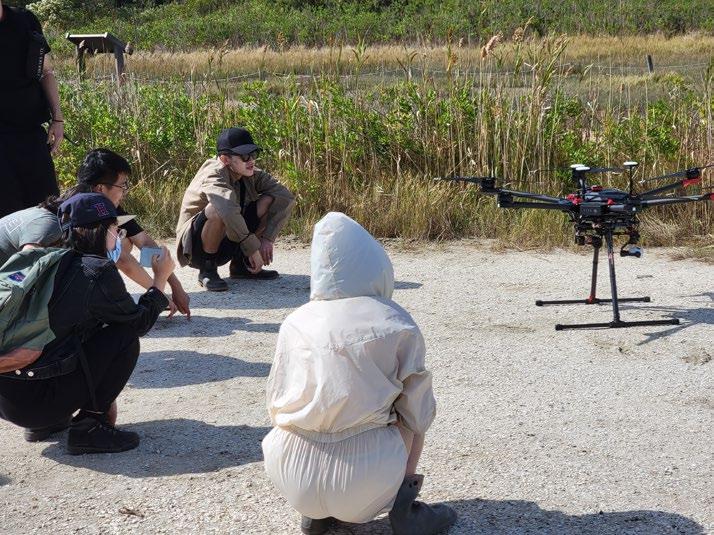
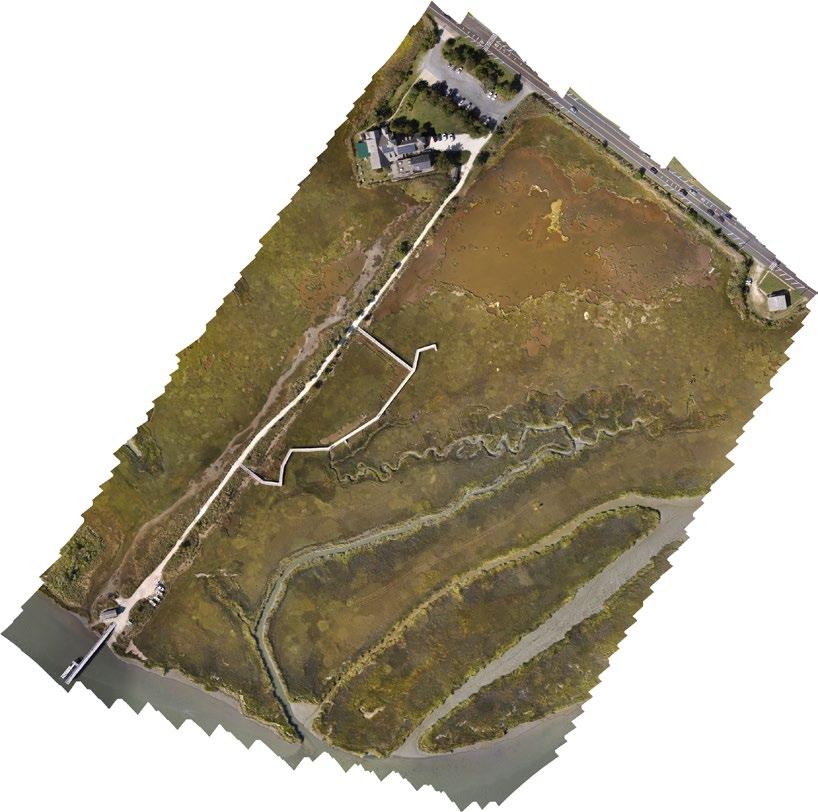
Throughout this process, we have been collaborating closely with the University of Pennsylvania Environmental Modeling Lab in the Weitzman School of Design. Using advanced tools including drones equipped with high-resolution visible and multispectral cameras, we have been mapping detailed marsh features, including different vegetation patterns, for the past 4 years. These data, along

imagery of TWI marshes
of marsh cover by type, created from drone photos
Our research scientists are using this newly acquired information to better understand marsh usage by diamondback terrapins and marsh nesting birds, and everyone at The Wetlands Institute is planning for how best to preserve and protect our treasured marsh resources. We are sharing our methods, results, and discoveries widely to enable the broader adoption and use of these tools over timeframes and scales that can make a difference. We'll also be sharing our work in upcoming newsletters and lectures at the Institute in the coming months.
Dr. Lenore Tedesco, Executive Director
Anne Brickley, Director of Administration
Dr. Lisa Ferguson, Director of Research and Conservation
Brooke Knapick, Director of Educational Program Development Research & Conservation
Julie Blum, Research Scientist
Samantha Collins, Research Scientist
Meghan Kolk, Conservation Scientist
Amanda Lyons, Research & Conservation Coordinator
Brian Williamson, Research Scientist Education
Danielle Meeker, Aquarist/ Environmental Educator

Kelianne O'Shea, Environmental Educator
Erin Rawls, Outreach Coordinator
Devin Griffiths, Marketing and Communications Specialist
Rae Griffiths, Office Assistant
Terrie Campbell, Financial Administrator
Bonnie Girard, Payroll and HR Coordinator
Carol Wyland, Finance Manager Administration
Kirsten Chervenak, Visitor Services Coordinator
Jeff Dix, Maintenance Technician
Kimberly Dmytro, Tidepool Shop Manager
Hours: Open Saturday and Sunday 9:30 to 4:30. Check our website for Holiday Hours.
General Admission: Members: Free.
 by Dr. Lenore Tedesco, Executive Director
by Dr. Lenore Tedesco, Executive Director
Many people ask me if things have slowed down now that the seasons have changed. The answer may surprise you. Our full-time year-round staff of 19 are always busy but our focus changes with the seasons. The research team is still in the field, but also analyzing data, preparing reports, writing grants, presenting their work to colleagues and peers, and planning for next year’s projects. The education team is delivering scout, homeschool, and outreach programs, continuing year-round animal care, attending conferences, and revising curricula, while our communications team is keeping our members informed and the news flowing. There is much to do with planning and renovations ahead.
of the importance of these ecosystems for our well-being. They are people, like you, that know our work is accomplished because of the broad support that we receive from our members and supporters. They recognize that we keep admission and program fees artificially low so that we can make sure our programs are accessible to all. They understand that our contract and grant work is competitively won and earned anew each year, without any guarantees. We are also able to accomplish so much because some of you underwrite programs with multi-year commitments, which is critical to helping maintain program effectiveness.
During the busier programming season, our staff numbers swell to 52 when we add educators, interns, admissions staff, and seasonal scientists and conservationists to fulfill our research, conservation, and education mission and welcome visitors. We serve more than 13,000 schoolchildren and 17,000 visitors each year, and have more than 1,300 members that come from 42 states (some from as far away as California and Hawaii) and Canada. Something you may find interesting is that only about 15 percent of our members visit the Institute. Instead, they use membership as their way to support the crucial work that we do to preserve and protect our coastal resources and teach people of all ages
As we look ahead to year-end, we rely on our members and supporters to once again show their commitment to ensuring that our important work can continue. We are always interested in expanding our circle of support, and one of the best ways we do this is with your help. If you are interested in supporting a specific program, there are many needs. If you would like to introduce a friend, corporation, or foundation to our work, I would welcome the opportunity to share our story. Our story is enriched by all of you and your commitment to helping us serve our mission. As yearend approaches, now is a great time to lend a hand. Thank you for all you do, this year and always.
Non-members: $8 Adults, $6 Children 3-12.
Views From the Tower is the quarterly newsletter of The Wetlands Institute and can also be found on our website.
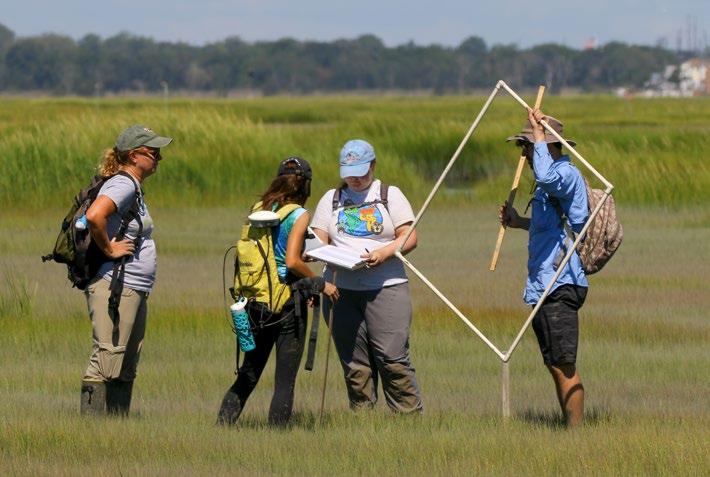
enjoyed all that the Island offers: Its beaches, its waterways, vistas, communities (both seasonal and yearround), eateries (candle-lit dinners for special evenings, takeout for casual meals at home), and on and on!
In my earlier years, I did not know of The Wetlands Institute; I did not contemplate environmental issues then… nor fully understand what challenges climate change would be bringing to our environments. I just enjoyed all the benefits… thoroughly. I just assumed they’d always be here… unfortunately!

Jersey, University of Penn, and others.
These days, I’m a regular Institute volunteer. I rollup sleeves and help however, whenever, and wherever I can. I do admit though, one of the reasons I volunteer is a bit selfish. Of course I want to help protect the marshes, enhance the animal life, maintain the waterways and vistas… but I also want to protect our family home and our future family gatherings here in Stone Harbor.
Stone Harbor and Seven Mile Island have been treasured spots for me since childhood. I’m one of those having a favorite relative – an aunt, in my case –who owns a family place on the Island. Aunt Peg is a favorite because she’s enlightened, she’s fun to be with, is a great cook – and yes, because she invites me to Stone Harbor… often.
Throughout the years, I’ve completely

However, fortunately, now I am familiar with The Wetlands Institute. Now I’m learning of the environmental challenges that we all face, and of the many opportunities before us – opportunities that the Institute’s research, educational, and outreach programs encompass. And I’m learning of the many promising findings of the Institute through its extensive, in-our-marshes, researchleaning collaborations with the US Army Corps of Engineers, the State of New
After the floodwaters caused by the remnants of Hurricane Ian receded from the marsh islands around the Institute, we discovered that our collaborators at Boston College lost some of their monitoring equipment for our work in the Seven Mile Island Innovation Lab (SMIIL) – including a few data loggers suspended from flotation rings. We put out a call for help on social media, and a couple with a house on Stone Harbor Boulevard responded. They'd found one of the systems while cleaning up after the storm and returned it to us. It was dirty and battered, but it was still working –and more importantly, we were able to retrieve the data we needed.
The data recorded by these systems is very important, and we were thrilled to have this one back. Thanks to Anthony and Gail Flynn for recovering the logger and bringing it in. It is a big help to the entire SMIIL team, and we all greatly appreciate it!
There are still two more of these out there somewhere; if you've seen or have managed to retrieve one, please contact us at staff@wetlandsinstitute.org or 609-368-1211.

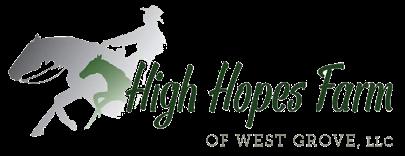
One of the many howevers for me, fellow Wetlands Institute friends, is contributing to the Institute – partly because I recognize that its work is critically important, and partly because I recognize that supporting TWI simultaneously supports my family and this community I treasure.
If you currently support and contribute to the Institute… thank you! If you’re not a supporter yet, won’t you please consider it? A contribution of any amount makes a difference. Thank you for helping to support The Wetlands Institute!
As we look to 2023 and beyond, we’ll be revamping many of our festivals to expand our celebration of the natural wonders around us. From the spectacle of bird and butterfly migrations to the excitement of the diamondback terrapin nesting season, we’re creating more opportunities for engagement and more chances for you to connect with the majesty of nature right here in our marshes, along our coasts, and in the back bays and channels of South Jersey. Stay tuned in 2023 for more information about the exciting changes in store!

Every year, in the early days of summer, Northern diamondback terrapin females emerge from the marsh to lay their eggs. If you’ve visited The Wetlands Institute during those months, you might have seen a terrapin yourself, or even helped a terrapin safely cross the road and wondered – what’s that turtle’s story? Every terrapin we encounter has its own life and story, and through our 30+ years of research we’ve learned a lot!
Our Terrapin Station exhibit focuses on educating visitors about these terrapins. Through generous funding from the Disney Conservation Fund, we’ve created eight different rotating “turtle profiles” that each feature a terrapin our researchers encountered that year, so that visitors can learn about the specific turtles we see on our property. Each turtle profile tells a story, and this year, our turtles range from one found trying to nest in a canoe to a recaptured terrapin that was originally tagged in 1997, making her older than several of our staff.
To make the exhibit accessible to all, we created a Virtual Terrapin Station as part of our Virtual Wetlands Experience. This online exhibit features all eight of our turtle profiles, as well as an interactive
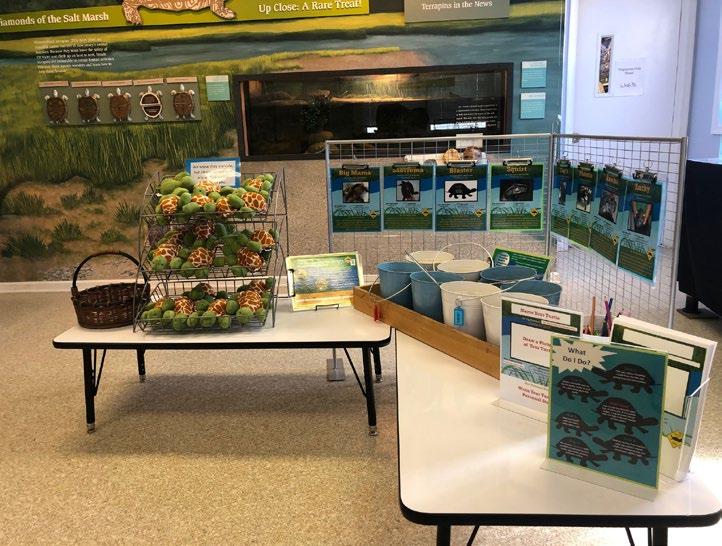
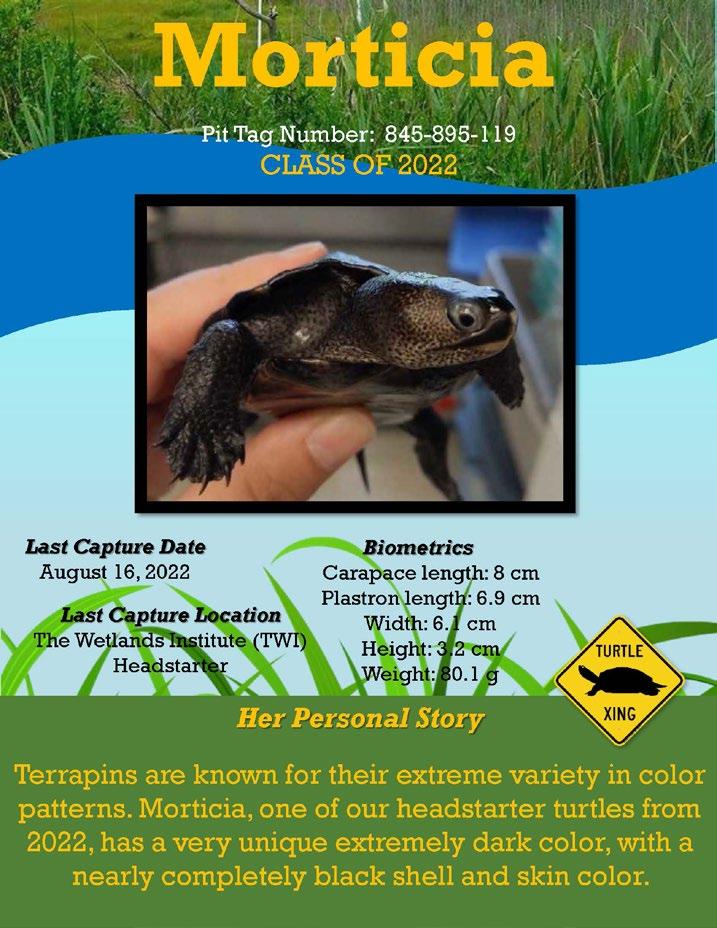
activity where virtual visitors can learn how our researchers track and monitor terrapins, and create their very own turtle profile. With additional funding from the Disney Conservation Fund, we plan to create a “Terrapins in the News” video segment, coming soon! Come check it out in person, or visit our Virtual Terrapin Station at: wetlandsinstitute.org/virtualwetlands-experience.
Each school year, The Wetlands Institute (TWI) partners with Lower Cape May Regional High School’s Structured Learning Experience Program. This program allows students to step inside local businesses and organizations to gain the experience needed to bolster a future career in their chosen field. This year, TWI is proud to host Wesley Wise, a senior at Lower Cape May Regional High School, as an Aquarium Intern. Every afternoon during the school week, Wesley volunteers in the Aquarium, performing duties that include cleaning turtle and fish tanks, collecting food and display animals, and feeding animals. Below is a brief interview with Wesley that explores his passion for marine science and his experience here at The Wetlands Institute.
Q: What interests you most in marine science?
A: The sea creatures! I love finding out what makes them unique. How they hunt and find prey and how they defend themselves.
Q: Describe your experience working with animals before starting at The Wetlands Institute.
A: My Dad and I collect some local fish and keep a small salt water aquarium. I also have two crested geckos. My Dad has eleven chickens… [and] my parents each have a dog that I help with; a lab, Louie, and a dachshund, Benson.
Q: What is your favorite marine animal? A: Octopus!
Q: What do you like best about interning at The Wetlands Institute?
A: I like that I can see a future for myself in what I am learning at The Wetlands Institute. My favorite thing to do in the Aquarium is feed the horseshoe crabs.
Q: What do you hope to take away from this experience?
A: I hope to learn skills that I can use in future jobs. One day I hope to work as an Aquarist or at an organization like The Wetlands Institute.
Still clad in waders, Wesley smiles after a fun afternoon seining in Scotch Bonnet Creek
 This year’s favorite turtle profile featuring a one-of-akind terrapin
The turtle profiles and interactive tracking activity in Terrapin Station
This year’s favorite turtle profile featuring a one-of-akind terrapin
The turtle profiles and interactive tracking activity in Terrapin Station

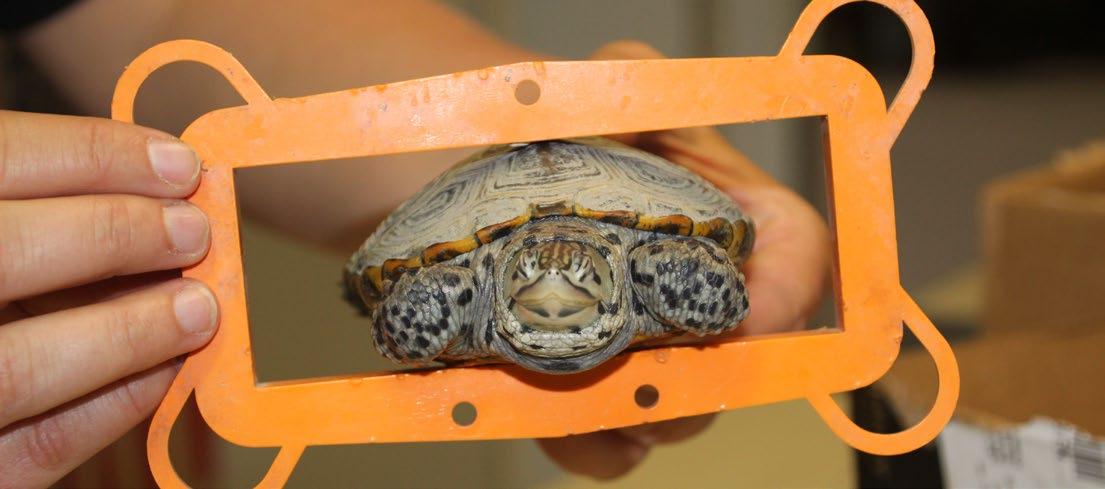 by Brian Williamson, Research Scientist
by Brian Williamson, Research Scientist
Diamondback terrapin populations in New Jersey face many threats, but the largest is bycatch in enclosed crab pots. Terrapins are attracted to bait and crabs captured in recreational and commercial pots. Once they find their way inside they cannot escape and, because terrapins breathe air, they frequently drown. The dead terrapins, in turn, can act as bait, drawing in more terrapins and creating a perpetual cycle. One way to reduce bycatch is through the use of a Bycatch Reduction Device (BRD). Developed in 1997 at The Wetlands Institute by Dr. Roger Wood, these devices fit into or over the funnel on a crab pot, reducing the entry size enough that they prevent adult female terrapins from entering while still providing access to even the largest crabs.
New Jersey’s coastal nesting birds have lost a substantial amount of habitat due to dense development – and sea level rise, sinking marshes, increased storm intensity, and flood frequency threaten what remains. As available marsh habitat sheltered from frequent flooding continues to disappear, identifying important nesting areas and understanding the factors that affect populations of saltmarsh breeding birds are essential to protect or improve habitat for these sensitive species.
During the 2022 nesting season, scientists at The Wetlands Institute (TWI) investigated habitat use, choice of nest sites, and reproductive success of Saltmarsh Sparrows and Seaside Sparrows (both highly secretive marsh nesting birds) in coastal wetlands within the Seven Mile Island Innovation Laboratory study area. Saltmarsh Sparrows are declining significantly, with an estimated nine percent population loss species-wide each year, prompting its consideration for federal listing as an endangered species. Seaside Sparrow population trends are not well understood.


In New Jersey, BRDs are currently only required on crab pots in waters less than 150 feet wide. However, diamondback terrapins occur in areas where BRDs are not required, and many of these places, such as the Delaware Bay, are active crabbing locations. Hundreds of terrapin carcasses wash ashore each year on the Delaware Bay having drowned in crab pots, and are documented by reTURN the Favor volunteers. The use of BRDs on all traps would reduce this number considerably.
The New Jersey Bureau of Marine Fisheries’ Blue Crab Committee will soon review recommendations from New Jersey Fish and Wildlife’s Endangered and Non-game Species Program that would require all crab pots fished in New Jersey waters to be equipped with BRDs. The recommendations also include adopting the smaller (1.8 x 5 in) style of BRD used in New York, Delaware, and Maryland as opposed to the larger (2 x 6 in) style currently required in New Jersey. Following committee review, the Marine Fisheries Council will meet in early 2023 to vote on these recommendations and this meeting will be open to the public. Please stay tuned for more information about how you can make your voice heard on this important conservation issue.
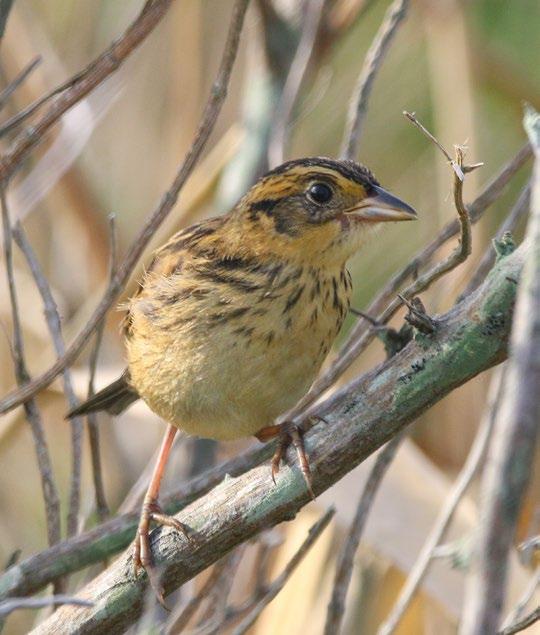

Through the use of acoustic monitoring devices and direct surveys of specific key marsh sites, we explored where these species occurred and where they chose to nest within restored and natural marsh areas.
According to our initial results, these birds preferred to nest in marsh areas on or directly adjacent to historic dredge placement sites. These areas offered both higher elevation and vegetation the birds preferred, though flooding still occurred at several of the nests we monitored. We did identify a key nesting area on Gull Island that provided suitable habitat to allow both Saltmarsh and Seaside Sparrows to fledge young. However, as with other study areas, certain nests within this area were vulnerable to flooding, depending on the exact nest location and changes in water elevation. As we continue our work, results from our ongoing efforts will help provide recommendations for continued maintenance and monitoring, and guide considerations for future project development related to beneficial use of dredged materials to assist these at-risk species.

Salt marshes and coastlines are dynamic environments by nature, affected by changes on timescales ranging from hours to years to decades: the stately waltz of the tides; the energetic tango of the ebb and flow of life; the jazzier beat of seasonal storms rolling through; and the punctuated, chaotic staccato of the effects of climate change.
For the past several years, many of these changes have been accelerating – in particular, those driven by human activity –with the onslaught of rapidly rising seas at the forefront of issues affecting our coastal landscape. Seas are rising faster than our marshes can keep pace, marshes are flooding too frequently for marsh-nesting birds to successfully rear their young, and some marshes are converting to tidal mud flats. Make no mistake: climate change isn’t coming, it’s here. This has serious implications for the wetlands and their ability to shield us from storms and serve as a life-support system for fisheries and migratory birds.
In 2019, The Wetlands Institute, the US Army Corp of Engineers, and the NJ Department of Environmental Protection together created the Seven Mile Island Innovation Lab (SMIIL) so that we could take action. Since the Lab’s founding, we have implemented eight projects to restore wetlands, slow wetland loss, and rebuild lost wildlife habitat. Using clean dredged material from the New Jersey Intracoastal Waterway, and through a combination of engineering and natural processes, we’ve been able to treat more than 60 acres of marshes.
In March 2020, SMIIL partners began an elevation enhancement project on Sturgeon Island in Great Sound, which, along with neighboring Gull Island, hosts more than 35 percent of New Jersey’s nesting wading birds – including Great and Snowy Egrets, Little Blue and Tricolored Herons, Black-crowned NightHerons, and Glossy Ibis. Habitat degradation is affecting nest success, though, and both islands are drowning.

Sturgeon Island became our test bed. We developed several dredging and material placement tools there that we then
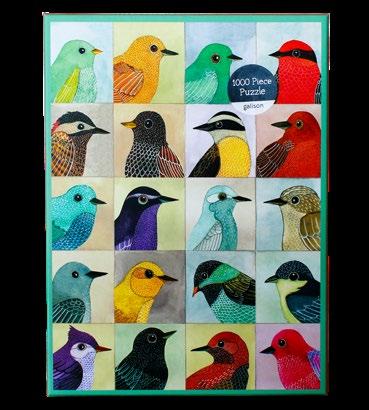

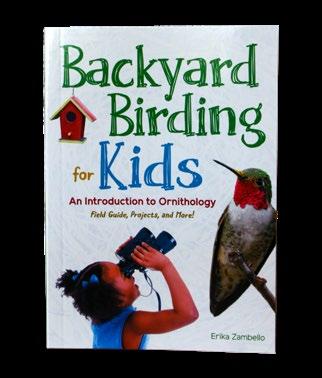
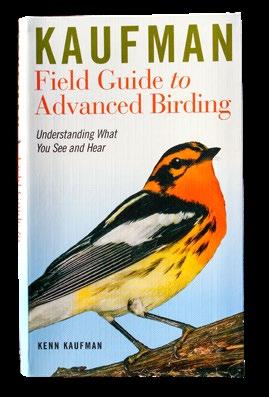
Though this year's fall migration has run its course, it's never too early to start preparing for spring – and the Tidepool Shop has everything you need to get ready for the return of our feathered wanderers! From serious birders to armchair enthusiasts, from the youngest beginners to the most seasoned veterans, we have a selection of books, guides, puzzles, and games sure to spark your interest, fire your imagination, and have you pining for spring.
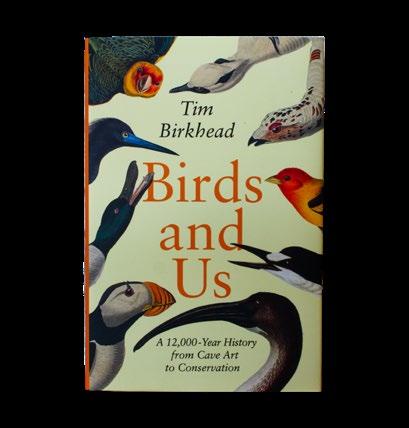


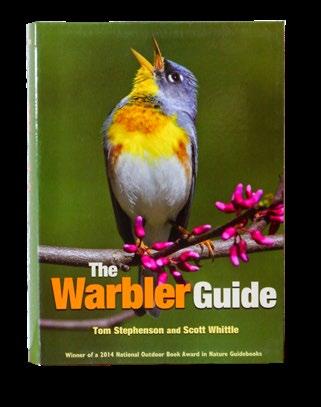
As always, your purchase at the Tidepool Shop directly supports our important work here at The Wetlands Institute - Thank You!
implemented on both Sturgeon and Gull Islands. On Gull, we placed more than 40,000 cubic yards of material to enhance marsh elevation, restored exceptionally low portions of the island that were devoid of marsh grass, and created sandy marsh edge protection features – an experimental approach to try to prevent breaking waves (largely from boat wakes) from damaging the marsh edge. After two years of monitoring, results are excellent.
The marsh edge feature is effectively intercepting boat-wake waves; bottom-dwelling plants and animals quickly inhabited the newly placed sediment; and we were able to raise the marsh platform at both islands up to three feet in some areas, reversing marsh loss and restoring drowned areas back up to suitable elevations for recovery. Marsh grasses are naturally growing on the dredged materials, increasing marsh area and ensuring the marshes can last for decades to come. Areas of persistent tidal flats have been shallowed and are now hosting thousands of migratory shorebirds as they feed and rest. These results clearly demonstrate the value of beneficial use projects, and they have the potential to create a sea change for our marshes and the wildlife that depend on them.
These are exciting times, and The Wetlands Institute is extremely pleased to take on a leadership role studying, preserving, and conserving these marshes and coastal ecosystems well into the future. To learn more, visit wetlandsinstitute.org/smiil
Our book and gift shop is open on Saturday and Sunday from 9:30 to 4:30. Can’t visit us? Give us a call or shop online at tidepool-shop.myshopify.com.
Holiday hint: These make great stocking-stuffers!
As the snow starts to fall, join us all winter long for activities on the marsh every Saturday and Sunday. Unless otherwise stated, all activities are free with admission and occur onsite at The Wetlands Institute. Visit wetlandsinstitute.org/events for up-to-date information.
Seasonal Science Activities
10 AM to 4 PM Saturday and Sunday
Each month we will offer a new self-guided science activity related to seasonal changes in nature. We provide the supplies and you create the learning!
2 PM Saturday
During this live animal presentation, get up close with turtles, fish, crabs, sea stars and urchins, mollusks, horseshoe crabs, or the popular animals of Finding Nemo. After the presentation, create your very own take-home craft!

Aquarium Feeding
11 AM Saturday
Help us feed the local marine life! We will open up feeding once a week so you can see the burrfish eating crabs and the horseshoe crab gobbling shrimp.
Sunday 11 AM
Learn about local creatures found in the salty waters of the ocean or back-bay! Join an Institute educator for a unique, interactive learning experience as they teach about whelk, sea urchins, sea stars, mud snails, horseshoe crabs, and more!
Join us as we explore conservation issues ranging from Bats to Seafood to Terrapins, or dive deeper into the lives of the LenniLenape and the unseen world of Ultraviolet-induced Visible Fluorescence and Plankton, or uncover the hidden dangers of Marine Debris and Climate Change.
Miss your favorite animals? Enjoy a virtual visit to The Wetlands Institute, anytime and anywhere, by visiting the Aquarium Bytes section of our Virtual Wetlands Experience portal on our website: wetlandsinstitute.org/ aquarium-bytes.



Our members are the backbone of The Wetlands Institute. When you give the gift of membership, you not only support our mission but you allow us to advance our impactful research, conservation, and education work. Annual memberships start at $25 and provide free admission, a 10% discount on most items at our Tidepool Shop, and discounted rates on most special events and programs. You can purchase memberships on our website, by phone at 609368-1211, or by visiting The Wetlands Institute.
Adoption programs help you learn more about the coastal animals you love while supporting the work we do to study and protect them. Each program has several options to symbolically adopt an animal and receive an adoption certificate, educational newsletter, and other fun items. Adoptions make great gifts, too! Check them out on our website, www.wetlandsinstitute.org/adopt.
1075 Stone Harbor Blvd. Stone Harbor, NJ 08247-1424




A non-profit organization studying, preserving, and protecting wetlands and coastal ecosystems
As a conservation organization, we have a special responsibility to address the global challenges of climate change and sustainability. We are committed to minimizing environmental impacts in all aspects of our operations. Visit our website at wetlandsinstitute.org/about-us/ sustainability/ for more on our sustainability initiatives.
The only thing that stays the same is change – and here in the marsh, change is a constant. We see it in action every day, from the regular cycle of the tides to the biannual migration of birds to the dramatic increase in “sunny day” flooding of the marsh – a visible sign of the rise in sea level that threatens coastal habitats and the wildlife and communities they shelter.
For more than 50 years, The Wetlands Institute has been creating positive change in the world around us – preserving wildlife and habitat through dedicated conservation efforts, connecting people to nature through engaging, hands-on education programs and opportunities, and helping our marshes respond to sea level rise through groundbreaking research projects.
Throughout all this change there's been another constant: your support . The generous support of people like you helps make our work possible. As you think about your year-end charitable giving, we hope we can count on you again. You truly make a difference. Please, make a gift today
P.S. The Institute building turned 50 this year, and it, too, must be prepared for the changes to come. With your help, The Wetlands Institute of the next 50 years will be a model for building resiliency and living in concert with nature.